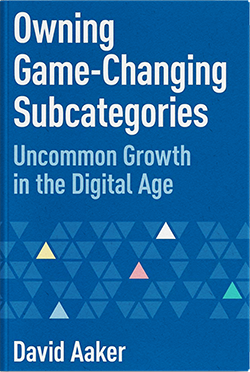BOOK
Owning Game-Changing Subcategories
DAVID AAKER

Summary
The only way to grow (with rare exceptions) is with “must-haves” that define game-changing subcategories. These subcategories must offer new or markedly superior customer experiences or brand relationships, an exemplar brand that positions the subcategory and creates barriers to competitors.
Subcategory-driven growth has exploded in the digital era because of technological advances and the fast, inexpensive market access made possible by e-commerce and digital communication.
The alternative, “my brand is better than your brand” competition, rarely generates growth because markets are so stable and difficult to disrupt. The book includes case studies from numerous companies including Airbnb, Etsy, Warby Parker, Prius and Muji to illustrate how subcategory creation has led to uncommon growth.
Highlights
- Explanation of why growth almost always involves “must-haves” defining new subcategories, earning exemplar brand status, and creating competitor barriers
- Tips for finding “must-haves” and examples with case studies featuring notable leading brands
- Deep dive into how digital tech trends like e-commerce, the Internet of Things, brand communities and more that drive growth through subcategory formation
Endorsements
I really LOVE this book!! It is so right for organizations looking to drive growth. Through compelling insights, Aaker shows how to employ the Digital Revolution to create and own Subcategories highly relevant to customers. A MUST READ book for our Digital times!
Joe Tripodi
Former CMO of Coca-Cola, Allstate, MasterCard, and Subway
David Aaker uses economics and case studies to show how growth comes from inspired breakthroughs that create new subcategories and not from expanding market programs. Use the 20 takeaways to find your own subcategory breakthrough.
Philip Kotler
The Father of Modern Marketing
David Aaker teaches us how to grow in the digital era by harnessing the power of subcategories. A must have for all business leaders.
Yong-Jin Chung
Vice Chairman, Shinsegae Group (Korea’s Largest Retailer)
Media
“From Brand to Subcategory Competition” in European Journal of Marketing, Fall 2018
“Winning in the Sharing Economy—Six Keys to Airbnb’s Success, ‘ Journal of Brand Strategy, February, 2019.
About the Author
David Aaker, is the author of more than one hundred articles and 17 books on marketing, business strategy, and branding that have sold over one million copies. A recognized global authority on branding, he has developed concepts and methods on brand building that are used by organizations around the world.
Connect
Want to interview Dave or feature him on your next podcast? Please connect with us or David Aaker directly.
Explore how David Aaker and Prophet can help your business create game-changing brands that resonate with both your customers and employees.











